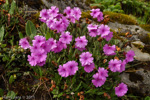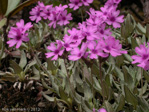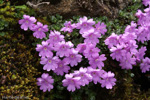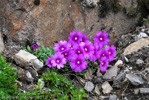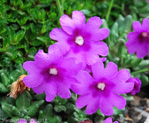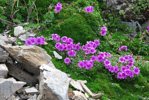Primula dryadifolia Franch.
Section Dryadifolia
Link to Flora of China description
Flora of Bhutan
Type specimen: Delavay Primula no. 4, Yunnan, glacier de Li-kiang, alt. 4000 metres - Juillet 1884 resides at P (specimen P04571953 (lectotype)) and G (specimen G00440587).
Primula dryadifolia subsp. dryadifolia
P. chrysophylla Balf.f. & Forrest (syn): Type specimen: Forrest 16594 resides at E (specimens E00024122,E00024123) and P (specimen P04571853).
P. dryadifolia subsp. chrysophylla (Balf.f. & Forrest) W.W.Sm. & Forrest (syn): Notes Roy. Bot. Gard. Edinburgh. 16: 22. 1928.
P. congestifolia Forrest (syn): Type specimen: Forrest 478 resides at E (specimens E00024436,E00024803).
P. dryadifolia subsp. congestifolia (Forrest) W.W.Sm. & Forrest (syn): Notes Roy. Bot. Gard. Edinburgh. 16: 22. 1928.
P. cycliophylla Balf.f. & Farrer (syn): Type specimen: Farrer & Cox 1183 resides at E (specimen E00024435).
P. dryadifolia subsp. cycliophylla (Balf.f. & Farrer) W.W.Sm. & Forrest (syn): Notes Roy. Bot. Gard. Edinburgh. 16: 22. 1928.
P. mystrophylla Balf.f. & Forrest (syn): Type specimen: Forrest 14221 resides at E (specimen E00024444).
P. philoresia Balf.f. (syn): Type specimen: Ward 798 resides at E (specimen E00024121).
P. dryadifolia subsp. philoresia (Balf.f.) Halda
P. dryadifolia subsp. jonardunii (W.W.Sm.) F.H.Chen & C.M.Hu
P. jonardunii W.W.Sm. (syn): Type specimen: White 69 resides at E (specimens E00024439,E00024440) and K (specimen K000750310).
P. oreina Balf.f. & R.E.Cooper (syn): Type specimen: Cooper 4247 resides at E (specimens E00024441,E00024442,E00024443) and P (specimen P04567172).
P. tsongpenii H.R.Fletcher (syn): Type specimen: Ludlow, Sherriff & Taylor 5865 resides at E (specimen not barcoded or online) and BM (specimen BM000996896) and US (specimen 00116521).
P. dryadifolia subsp. chlorodryas (W.W.Sm.) F.H.Chen & C.M.Hu
P. dryadifolia var. chlorodryas (W.W.Sm.)A.J.Richards (syn)
P. chlorodryas W.W.Sm. (syn): Type specimen: Rock 17027 resides at E (specimen E00024120) and A (specimen 00073536) and F (specimen V0067874F) and K (specimen K000750080) and P (specimen P04571861) and S (specimen S09-46736).
Epithet: Named for leaves siimilar in shape to Dryas octopetala.
Distribution: China: Sichuna, Yunnan, Tibet (Xizang), Bhutan, Myanmar, India: Arunachal Pradesh.
Forms dense cushions with multi-branched, woody rhizomes covered in the remains of old foliage. Leaves vary in size (smallest in P. mystrophylla), have a distinct, winged petiole, blade broadly ovate to elliptic, rounded or obtuse at the apex, truncate, cordate or broadly cuneate at the base and crenate and tightly recurved at the margin. Densely covered with white or yellow farina below (sometimes only glandular), subglabrous or sparsely glandular pubescent above. Scapes to 10cm, pubescent, sparsely farinous at the apex with 1-5 pink to rose flowers with a dark eye or sometimes lighter or whitish eye. Bracts are broad, oblong-ovate to elliptic, often tinged with purple. Calyx broadly campanulate, farinous at the base, parted to middle.
Numerous species were described though the Flora of China separated subspecies based on color (yellow in subsp. chlorodryas) and hairs present at the throat (in subsp. jonardunii). I am following the Flora of China here. Images from Bhutan, near the type location of P. jonardunii, show that the amount of hairs vary and may look less dense when the flower is a pin, with the stigma projecting out of the hairs. The notes for the type collection of Primula tsongpenii say "close to Primula jonardunii" and that the leaves have farina below (the description says efarinous) and I believe this species represents a synonym of P. dryadifolia subsp. jonardunii. If you have an image of P. dryadifolia with a tuft of hairs in the throat from near Mainling, Tibet, please contact the webmaster.



